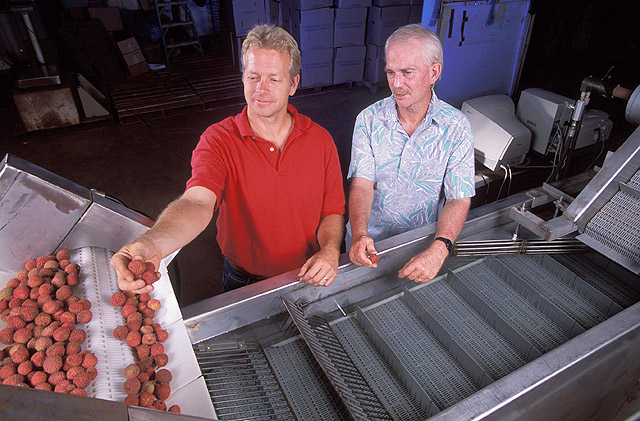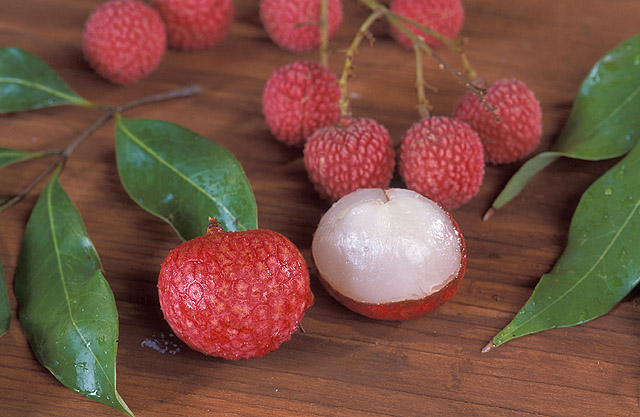From USDA-ARS Subtropical Horticulture Research Laboratory
by Marcia Wood
New Options for Lychee and Longan Fans and Farmers
Published in the May 2004 issue of Agricultural Research magazine
Maybe you've eased into an elegant dinner with a bowl of
chilled lychee soup or lingered over a delicious dessert of lychee ice
cream. This tropical delicacy and its smaller cousin, longan, are
intriguing ARS scientists in Hawai'i. Based at the U.S. Pacific Basin
Agricultural Research Center in Hilo, these ARS experts are
investigating ways to help growers bring more of these exotic fruits to
you.
Hot Bath Foils Insect Foes
Packinghouse
managers must ensure that the fruit they ship isn't harboring live
lychee fruit moths or oriental fruit flies; such stowaways could wreak
agricultural havoc. Irradiation, one option for disinfesting the fruit,
doesn't comply with organic produce standards.
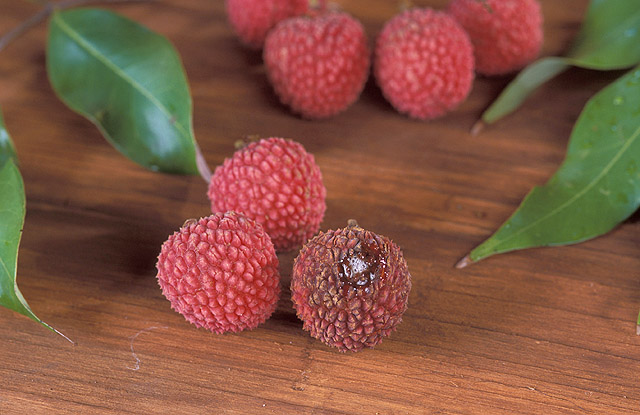 |
Fig. 1 
Fruit
flies deposit their eggs through the thin skin of a lychee, causing
juice to ooze out and stain the surface. But lychee is a poor host, and
fruit fly larvae rarely develop in the fruit.
ARS
entomologist Peter Follett and colleagues have developed an alternative
that may help growers expand their markets. The team designed, built,
and tested a twin-tank system that provides a hot-water bath to kill
these insects, followed by a cooling dip to protect the fruit's
delectable qualities.
Fig. 2 
Entomologist
Peter Follett (left) and tropical fruit grower Michael Strong installed
the first hot water immersion quarantine treatment unit for lychee and
longan, shown here, at Kahili Farms on the Island of Kauai.
The
unit features submerged, articulated plastic conveyor belts studded
with rubber cleats. These tracks take fruit smoothly in and out of the
heating and cooling tanks. The hot-water tank is calibrated precisely
to meet federal standards: The fruit is submerged for 20 minutes in
water heated to 120°F. The subsequent trip through the cooling tank
helps prevent spoilage. Neither bath harms the pleasant fragrance or
appetizing, slightly firm texture of the fruit.
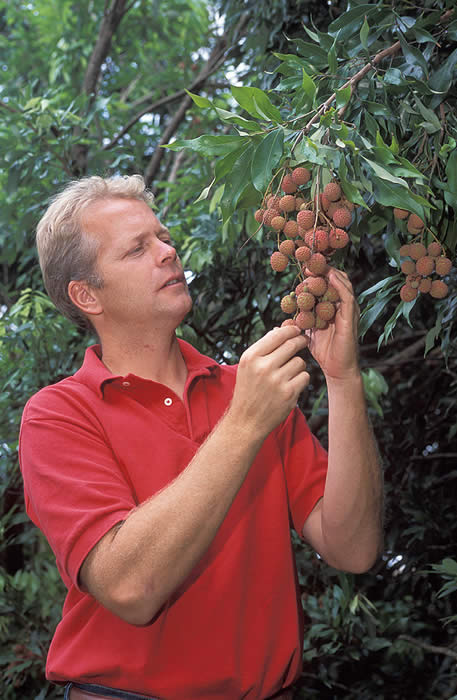 | Fig. 3
Entomologist Peter Follett inspects a panicle of ripening lychee fruit for insect damage. |
Follett
worked with Glenn McHam of MMG Manufacturing, Inc., a Fresno,
California, commercial equipment fabricator; John White, a Fresno-based
designer of agricultural equipment; and Mike Strong, owner of Kahili
Farms, Kilauea, Hawai'i, one of the state's premier growers and packers
of tropical fruit. Kahili Farms, where Follett is fine-tuning and
demonstrating a commercial prototype of the dual-tub process, is in the
final stages of obtaining federal approval for the unit.
Fusing the Ancient With the Modern
Quirks
in timing of lychee and longan flowering and, therefore, fruiting lead
to either boom or bust harvests. Explains ARS horticulturist Tracie
Matsumoto, "Growers are left with too much fruit one year and too
little the next. Ideally, lychee and longan crop yields would be even
and predictable, like apple harvests."
In her Hilo laboratory,
Matsumoto is currently fusing ancient knowledge of Chinese firecracker
ingredients with contemporary discoveries from a plant called thale
cress, Arabidopsis thaliana.
Chinese firecrackers, used for
more than 500 years in religious celebrations and other events, enter
the picture through a fascinating phenomenon noted in Taiwan.
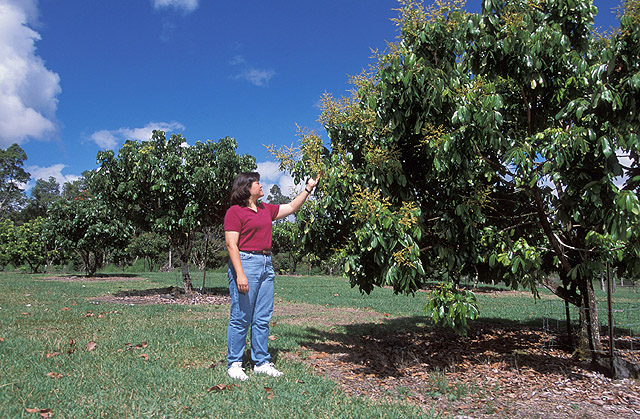 | Fig. 4 
Horticulturist Tracie Matsumoto observes a flowering longan tree. |
"Longan
trees growing near temples in that country," says Matsumoto, "were
found to form flowers and then bear fruit shortly after religious
ceremonies in which fireworks were used. This occurred even outside the
typical growing season."
Studies reported in 2000 by Chung-Ruey
Yen of the National Pingtung University of Science and Technology in
Taiwan suggested that a chemical in the ashes of the firecrackers
settled in soil around the trees and triggered flowering.
So how does thale cress fit into the Hawai'i experiments?
Fig. 5 
Lychee, Litchi chinensis,
was first introduced into Hawai'i 100 years ago but has been cultivated
in China for nearly 4,000 years. Peeled before eaten, the fruit is
whitish colored, as seen on the right.
Scientists
find thale cress to be a perfect subject for studies of the structure
and function of plant genes. That's because thale cress has very few
genes, making the task significantly less complex. While examining the
plant, researchers at several labs found that one of its genes, flc,
represses flowering. Yet by some unknown mechanism, other thale cress
genes are able to overcome flc to induce the plant to bloom.
"We
want to see whether a repressor gene, like flc in thale cress, exists
in crops such as lychee or longan," explains Matusmoto. "And we want to
find out whether a firecracker chemical somehow interacts with the
repressor gene or other genes to overcome the antiflowering effect.
Once we know that, we might be able to take advantage of this
phenomenon by using a less-explosive version of the fireworks chemical
to cue flowering.
"The lychee and longan industry in Hawai'i is
still quite small, with just a few farms and some productive backyard
trees," she says. "But growers are planting more and more trees. We
want to help these farmers succeed."
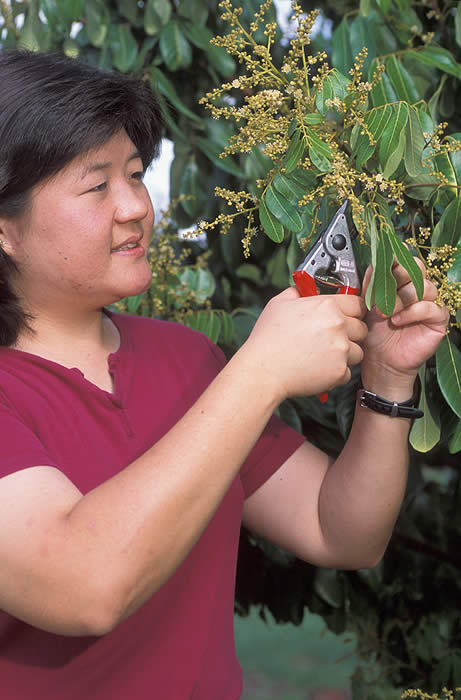 | Fig. 6 
Horticulturist Tracie Matsumoto collects a sample from a longan tree to isolate the genes involved in flowering. |
Savvy Scientists Share Lychee Expertise
In
the meantime, growers do have some tactics at their disposal to help
them sidestep the problem of unpredictable harvests. "Growing Lychee in
Hawai'i," a popular leaflet published by the University of Hawai'i in
1999, presents guidelines on everything from how to select the
best-performing trees to how to properly prune, fertilize, and irrigate
them.
Francis Zee, horticulturist and curator of ARS's tropical
fruit and nut collection at Hilo, developed some of these techniques in
experiments with lychee trees planted near his laboratory and at an
orchard in Kona, some 120 miles away. Then he teamed with other
specialists in Hawai'i to summarize everyone's recommendations and
present them in the text, tables, and diagrams that make up the
leaflet. "From running a lychee repository for more than a decade,
we've learned a lot of secrets about how to grow this crop," says Zee.
World's Lychees Safeguarded
The
repository that Zee manages serves as a botanical library. Living
examples of lychee, longan, and about a dozen other tropical crops are
preserved for the future and are available today for use by scientists,
growers, and farm advisors. This treasury is part of the nationwide
network of ARS-managed plant collections.
"The lychee and longan
collections here at Hilo are among the best outside of China and
southeast Asia," says Zee. "Some lychees were brought from southern
China in the 1940s by Dr. George Groff, and were donated to us by the
University of Hawai'i, where Groff was a professor.
"Dr. Philip
Ito and I obtained more recent acquisitions, added in the late 1980s
and throughout the 1990s. Before he retired from the university, we
collected in Thailand, China, and Taiwan. We also received additional
specimens by exchanging material with scientists of those countries,"
Zee adds. In 2002, Zee made a preliminary exploration of a wild lychee
forest on China's Hainan Island, southwest of Hong Kong in the Gulf of
Tonkin. He established contacts with some of China's leading
horticulturists and is making plans to return.
The
ARS
repository at Hilo houses many kinds of lychee that are grown in
Hawai'i. These boast a delightful range of shapes, colors, and sizes.
Hak Ip, for example, has thin, smooth, dull-red skin; round- to
heart-shaped fruit; and a single, large seed inside. Chen's Purple has
bright, purplish-red skin and elliptical fruit. No Mai Tsz, the world's
most sought-after lychee because of its exceptional flavor, often has
only a single, shriveled seed inside, nicknamed a "chicken tongue" for
its odd appearance.
The collection also includes India's Bengal;
Kwai May Pink, developed in Australia; and Groff and Kaimana, selected
from other candidate lychee trees for their adaptability to Hawai'i's
soils and climates. All are descendants of China's Litchi chinensis, the source of every domesticated lychee on the planet. Luscious Longan from Around the Globe.
The
longan collection at Hilo is composed of varieties from China, where it
is native, and from other locales. "We have Tiger Eye and Ta u Yu from
China; Si Chompoo and Biew Kiew from Thailand; and Kohala from Hawai'i,"
Zee explains.
"The Thai specimens are more suitable for Hawai'i,
and are more consistently productive here, than those from China,
probably because Thailand's climate is more nearly like that of Hawai'i.
Our collection includes Hawai'i's own, unique longan variety, Egami,
selected by Dr. Ito. We also have the malesianus
subspecies, which bears a soft, soapy-tasting fruit. It has bumpy,
light-mustard-yellow skin instead of the smooth, dark-mustard-brown
peel of its relative, Dimocarpus longan—the domesticated fruit."
Zee
is collaborating with a team led by ARS plant physiologist Paul Moore
at Aiea, Hawai'i, to probe the genetic makeup of lychee and longan. The
intent? To verify work done in 1995 by the repository staff to sort out
exactly who's who among these fruit varieties. That early work
untangled some of the confusion that, understandably, resulted when
traditional names of lychee and longan varieties were translated from
the original Chinese into English. Now, Moore's team is using newer,
more precise DNA-analysis techniques that, earlier, weren't as
available to the repository investigators.
"Collecting,
preserving, and classifying lychee and longan trees is especially
critical," Zee emphasizes. "It's urgent that this happen before old
lychee and longan forests in Asia are destroyed for development or
before older varieties are displaced—in commercial
groves—by new ones.
"With the help of our collaborators
here and overseas, we can continue to expand the collection and
contribute to the knowledge about these fruit species. That way, we can
improve the care of these wonderful gifts that the world has inherited
from China."—By Marcia Wood, Agricultural Research Service
Information Staff.
This research is part of Plant, Microbial,
and Insect Genetic Resources, Genomics, and Genetic Improvement, an ARS
National Program (#301) described on the World Wide Web at
www.nps.ars.usda.gov.
To reach the scientists named in this article,
contact Marcia Wood, USDA-ARS Information Staff, 5601 Sunnyside Ave.,
Beltsville, MD 20705; phone (301) 504-1662, fax (301) 504-1641.
Back to
Lychee Page
Longan Page
|
|


